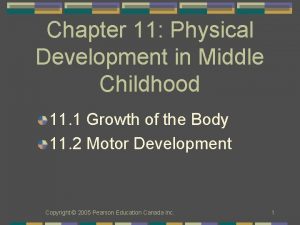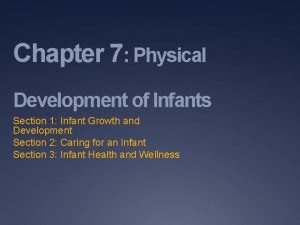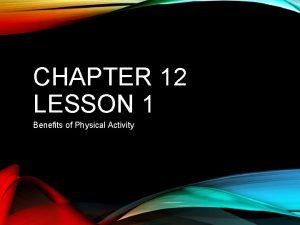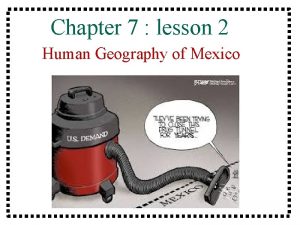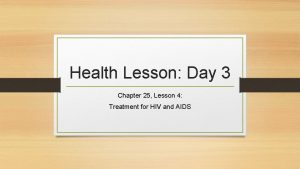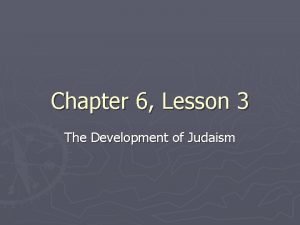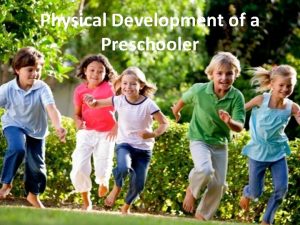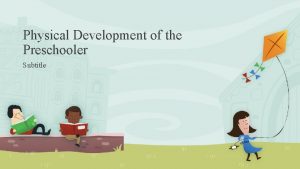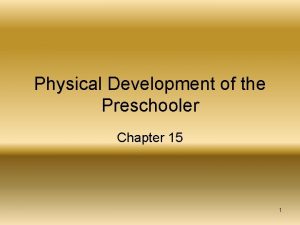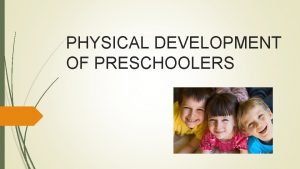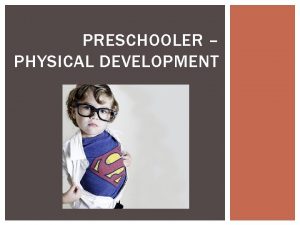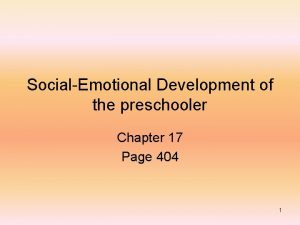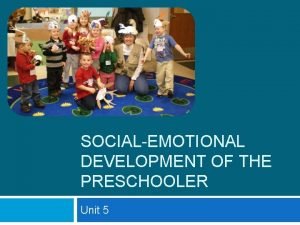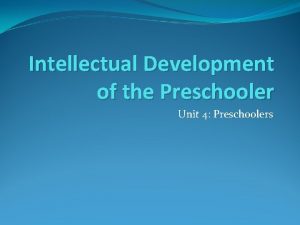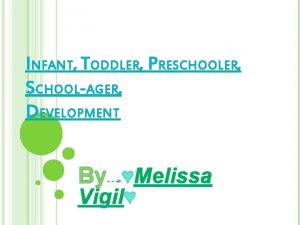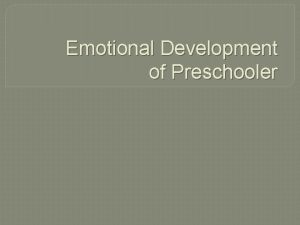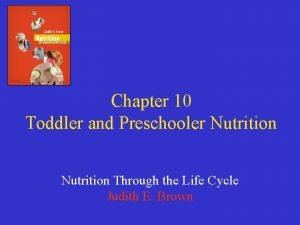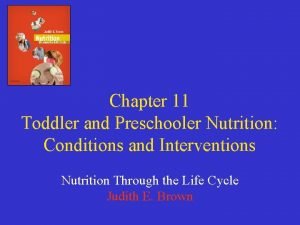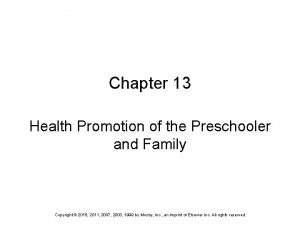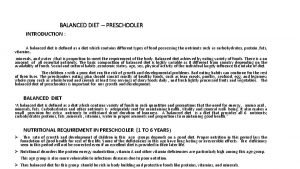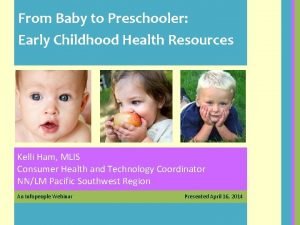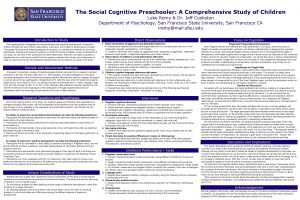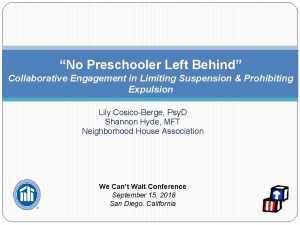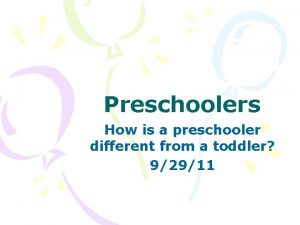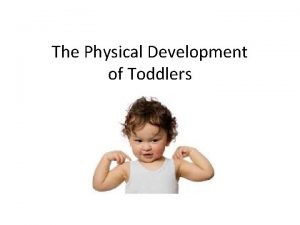Chapter 15 Physical Development of the Preschooler Lesson




























- Slides: 28

Chapter 15 Physical Development of the Preschooler

Lesson Essential Questions 1. What is the physical development that occurs in preschool children? 2. What are preschoolers’ gross and fine motor skills?

Body Growth & Development

Height & Weight • Most preschool children grow steadily at 2 1/2 -3 inches each year. Girls are on average shorter than boys, but the difference is ½ or less. • The rate of weight gain slows during the preschool years. Preschoolers gain 3 -5 pounds per year. 75% of that weight gain is due to muscle development. Because boys have greater muscle development than girls, they are on average a pound heavier than girls.

Other Body Changes • A preschooler’s body proportions begin to look more like an adult. The lower face grows more rapidly than the head. This helps the face look more like an adults. • During the preschool years the waist is smaller than the shoulders and hips. • The trunk grows to make room for internal organs. • The legs are about half of the length of the body. (the same as an adult’s leg: body proportions)

Bones & Teeth • Bones continue to ossify and grow larger and longer. • Deciduous (Baby) teeth begin to fall out between 4 -5 years old. • Adult teeth grow under the gums. Malnutrition can harm this growth. • Bones, muscles and joints are more prone to injury in preschool children than in older children.

Organs Hear rate slows and becomes steady. Blood pressure increases Breathing slows and becomes deeper Digestive tract is not as mature as other organs, and is irritated by high fiber foods & seasonings unlike an adult’s. • The brain continues to grow, but at a slower rate than before. • •

Fat and Muscle tissue • The ratio of fat: muscle tissue decreases slowly. • Most of the baby fat will have disappeared by the first day of Kindergarten with good nutrition and physical activity. • The tall, lean body of the preschooler is strengthened. This is due to skeletal muscles and bones that are made stronger by ossification. • Preschooler’s physical activity affects muscle development.

Why are a preschooler’s bones more prone to injury than those of older children?

Motor Development • Motor development improves due to physical activity and increasing body growth & development. • Better balancing skills • Eye hand coordination becomes more refined • Their reaction time becomes shorter • Able to perform more physical activities. Through play these skills develop quickly.

Gross Motor Development • Balance develops-this skill requires complex coordination processes. – Preschool children develop 2 kinds of balance: • Dynamic balance-while moving (walking, balance beam) • Static balance-balance while still (stand on one foot) • walking, running, jumping, climbing, throwing, catching, balancing, hopping, and skipping improve. • Their actions become more advanced in all areas. – Two new actions help throwing: body rotation & weight shift

What are some examples of the development of eye-hand coordination. What can a caregiver do to promote this development? Turn and discuss with a partner.

• http: //www. youtube. com/watch? v=41 TCj 4 INMM 0 Eye Hand Coordination and Motor Control Activity for Children • http: //www. youtube. com/watch? v=a 7 vv. MEW 9 z 8 Y Spooning: A Preschool Activity for Fine Motor & Concentration in Children • http: //www. youtube. com/watch? v=NG 7 fpe. Py_H k Shape Do-A-Dots • http: //www. youtube. com/watch? v=j. MWjb. XSe. H 4 Y Snowflake Lacing Card

Fine Motor Development • Preschooler’s ability to manipulate or work with by using the hands is still awkward but practice helps dramatically. • Improved eye-hand coordination helps fine motor skills.

The order of development • • The 3 year old Can feed themselves using a spoon and fork but are rather messy. They can build towers from small blocks, but the towers are crooked Can draw straight lines and copy circles Unbuttons and pull large zippers

The order of development • • • The 4 year old Movements are steadier May try to use knives when they feed themselves Are able to build straight towers and place blocks with steady hands Begin to cut on the lines with scissors Can comb their hair and wash their hands Can begin to use laces, but probably not tie their shoes.

The order of development • • • The five year old Eye-hand coordination is greatly improved Right or left hand preference is definite Uses a fork, spoon and knife to feed themselves Can build towers and place other small toys with skill. Can make simple drawings freehand. Can fasten large buttons and work large zippers

Chapter 16 Intellectual Development of the Preschooler

Lesson Essential Questions 1. How does new thinking skills emerge in preschoolers? 2. What are the major concepts learned at this stage of mental development? 3. What are the increasing language skills of preschoolers?

A preschooler’s world broadens • Preschoolers can interact with more objects and people. • They observe more and develop more advanced ideas about the physical attributes of things • They no longer rely on their senses and motor actions to learn about their environment. They can now solve problems mentally. • Growing language abilities are a bonus, not only in communicating but also in thinking in words. • Piaget describes the 2 nd stage of mental development as the preoperational stage. -the stage before logical thinking.

How Preschoolers Learn • Figure 16 -1: Piaget’s Stage of Cognitive Development • Pre-conceptual substage-2 -4 year olds are beginning to develop some concepts. They can form mental images, but many of these concepts are incomplete or illogical. • Intuitive substage-able to grasp a problem’s solution by how they feel about it. Through their intuition they base their solutions on “feeling” their way through problems rather than on logic.

Piaget’s stages

Obstacles to Logical thinking • Preschoolers do not think logically yet. • They are egocentric. • They center their attention on only 1 part of an object or event. They do not see all parts at the same time. (different sized glasses holding liquid) • They focus on single steps, stages, or events rather than see the order of changes. (like seeing each frame of a film separately rather than a running story) • They cannot follow a line of reasoning back to where it starts. They cannot retrace the steps to undo the task. • Preschoolers link actions without using logic.

New Abilities Emerge • Their problem solving skills depend on their memories of past sensory and motor experiences. The preschoolers’ thinking is marked by a number of new abilities-symbolic play, mental images, drawing, and language.

Symbolic Play • Preschoolers play many pretend many games. Objects may stand for anything the child wants, roles may change too. • These mentally changed roles and objects are symbols used to represent the pretend world and the child’s role in it.

Mental Images • Mental images are symbols of objects and past experiences that are store in the mind. • They are the pictures in the mind when words or experiences trigger the image. • Mental images are private and internalized (thought about only) • What mental images do you have when you hear these words…. .

Drawing • Preschoolers no longer scribble, they now attempt to draw objects and depict their world through drawings. • Drawing is a step between symbolic play and mental images because preschoolers draw first and then decide what their pictures represent.

Language
 Lesson 3 physical changes answer key
Lesson 3 physical changes answer key Chapter 10 physical development from one to three
Chapter 10 physical development from one to three Physical development in middle childhood chapter 11
Physical development in middle childhood chapter 11 Chapter 7 physical development of infants
Chapter 7 physical development of infants Chapter 15 lesson 1 physical geography of north africa
Chapter 15 lesson 1 physical geography of north africa Lesson 1 physical geography of eastern europe
Lesson 1 physical geography of eastern europe Chapter 12 physical activity and fitness
Chapter 12 physical activity and fitness Chapter 12 physical activity and fitness answer key
Chapter 12 physical activity and fitness answer key Glencoe health chapter 12
Glencoe health chapter 12 Chapter 7 lesson 2 human geography of mexico
Chapter 7 lesson 2 human geography of mexico States west of the mississippi
States west of the mississippi Chapter 25 lesson 1 health
Chapter 25 lesson 1 health Chapter 6 lesson 1 the israelites
Chapter 6 lesson 1 the israelites Lesson 3 the development of judaism
Lesson 3 the development of judaism Chapter 1 lesson 1 your total health lesson 1 quiz
Chapter 1 lesson 1 your total health lesson 1 quiz Hát kết hợp bộ gõ cơ thể
Hát kết hợp bộ gõ cơ thể Slidetodoc
Slidetodoc Bổ thể
Bổ thể Tỉ lệ cơ thể trẻ em
Tỉ lệ cơ thể trẻ em Voi kéo gỗ như thế nào
Voi kéo gỗ như thế nào Tư thế worm breton
Tư thế worm breton Chúa yêu trần thế
Chúa yêu trần thế Kể tên các môn thể thao
Kể tên các môn thể thao Thế nào là hệ số cao nhất
Thế nào là hệ số cao nhất Các châu lục và đại dương trên thế giới
Các châu lục và đại dương trên thế giới Công thức tiính động năng
Công thức tiính động năng Trời xanh đây là của chúng ta thể thơ
Trời xanh đây là của chúng ta thể thơ Cách giải mật thư tọa độ
Cách giải mật thư tọa độ Phép trừ bù
Phép trừ bù


